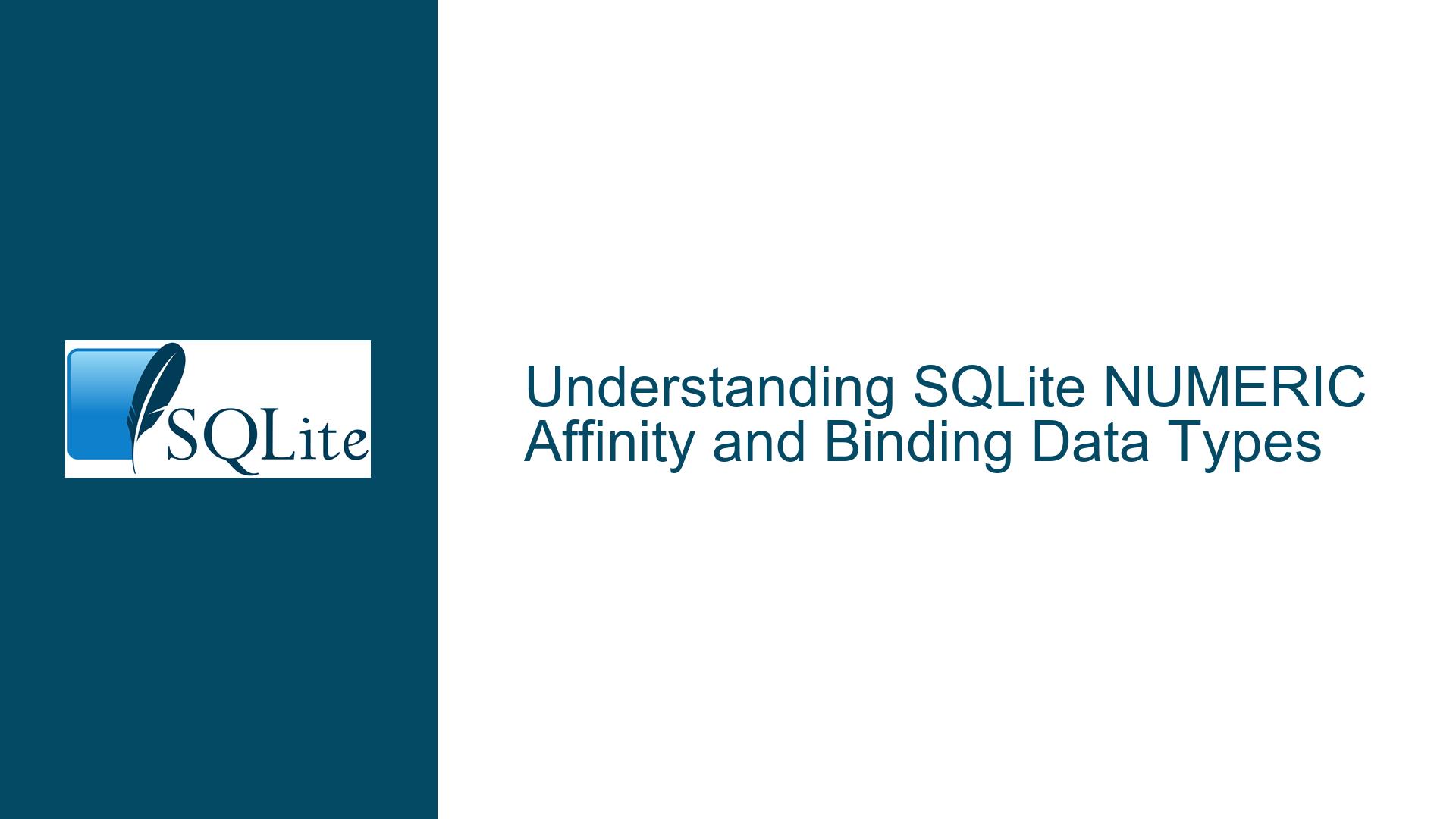SQLite NUMERIC Affinity and Binding Data Types
SQLite NUMERIC Affinity and Data Type Binding Confusion
SQLite’s handling of data types, particularly the NUMERIC affinity, often leads to confusion among developers, especially those transitioning from other SQL databases that enforce stricter type constraints. The NUMERIC affinity in SQLite is not a strict data type but rather a suggestion for how data should be stored and manipulated. This flexibility, while powerful, can lead to ambiguity when binding data types in applications, especially when dealing with columns declared as NUMERIC(10,2) or similar.
The core issue revolves around how SQLite interprets and stores data with NUMERIC affinity, and how developers should bind data types in their applications to ensure consistency and accuracy. Unlike other databases, SQLite does not enforce the precision and scale specified in declarations like NUMERIC(10,2). Instead, it uses a dynamic type system where any column can store any type of data, and the NUMERIC affinity merely suggests that the data should be treated as either an INTEGER or REAL, depending on the context.
This behavior can be particularly confusing when binding data in applications. For example, if a column is declared as NUMERIC(10,2), should the application bind the data as a double using sqlite3_bind_double(), or should it use a different binding function based on the actual data? The answer lies in understanding SQLite’s type affinity system and how it interacts with the application’s data handling.
Interplay Between SQLite’s Dynamic Typing and Application Data Binding
SQLite’s dynamic typing system allows any column to store any type of data, regardless of its declared affinity. This means that a column with NUMERIC affinity can store INTEGER, REAL, TEXT, BLOB, or NULL values. The affinity merely influences how SQLite attempts to convert data when inserting or querying. For example, if a value is inserted into a NUMERIC column, SQLite will attempt to store it as an INTEGER if possible; otherwise, it will store it as a REAL. If neither is possible, it will store the value as TEXT or BLOB.
This flexibility can lead to confusion when binding data in applications. For instance, if an application retrieves a value from a NUMERIC column, it must decide how to interpret that value. Should it treat it as a double, an integer, or a string? The answer depends on the application’s requirements and the nature of the data. If the application expects a floating-point number, it should use sqlite3_column_double() to retrieve the value. If it expects an integer, it should use sqlite3_column_int(). However, if the data could be of any type, the application must first check the type using sqlite3_column_type() and then retrieve the value accordingly.
The confusion is compounded by the fact that SQLite ignores the precision and scale specified in declarations like NUMERIC(10,2). This means that the application cannot rely on these declarations to determine how to bind or retrieve data. Instead, it must use the actual data type of the value, which can vary from row to row.
Strategies for Handling NUMERIC Affinity and Data Binding in Applications
To handle NUMERIC affinity and data binding effectively, applications must adopt a strategy that accounts for SQLite’s dynamic typing system. This strategy should include the following steps:
Determine the Expected Data Type: Before binding or retrieving data, the application should determine the expected data type based on its requirements. For example, if the application is working with financial data, it may expect floating-point numbers and should use
sqlite3_bind_double()andsqlite3_column_double()accordingly.Check the Actual Data Type: When retrieving data from a NUMERIC column, the application should first check the actual data type using
sqlite3_column_type(). This function returns one of the following values: SQLITE_INTEGER, SQLITE_FLOAT, SQLITE_TEXT, SQLITE_BLOB, or SQLITE_NULL. Based on the returned type, the application can then use the appropriate function to retrieve the value.Handle Type Conversion: If the application expects a specific data type but retrieves a different type, it must handle the conversion appropriately. For example, if the application expects a double but retrieves an integer, it can convert the integer to a double. Similarly, if it expects an integer but retrieves a string, it can attempt to parse the string as an integer.
Use Explicit Binding Functions: When binding data, the application should use explicit binding functions that match the expected data type. For example, if the application is binding a floating-point number, it should use
sqlite3_bind_double(). If it is binding an integer, it should usesqlite3_bind_int(). This ensures that the data is stored in the correct format and reduces the risk of type-related errors.Consider Using REAL for Floating-Point Data: Since SQLite’s NUMERIC affinity can store data as either INTEGER or REAL, applications that work with floating-point data should consider using the REAL affinity explicitly. This ensures that the data is always stored as a floating-point number, reducing the need for type conversion.
Implement Custom Data Handling for Complex Scenarios: In some cases, the application may need to handle complex scenarios where the data type is not known in advance. In such cases, the application can implement custom data handling logic that dynamically determines the appropriate binding or retrieval function based on the data type.
By following these strategies, applications can effectively handle NUMERIC affinity and data binding in SQLite, ensuring that data is stored and retrieved accurately and consistently.
Practical Examples and Code Snippets
To illustrate these strategies, let’s consider a practical example where an application needs to store and retrieve financial data in a SQLite database. The financial data includes amounts that are typically represented as floating-point numbers, such as 1234.56. The application uses a table with a column declared as NUMERIC(10,2) to store these amounts.
Example 1: Binding and Retrieving Floating-Point Data
// Example of binding and retrieving floating-point data in SQLite
#include <sqlite3.h>
#include <stdio.h>
int main() {
sqlite3 *db;
sqlite3_stmt *stmt;
const char *sql = "CREATE TABLE IF NOT EXISTS finances (id INTEGER PRIMARY KEY, amount NUMERIC(10,2));";
int rc = sqlite3_open(":memory:", &db);
if (rc != SQLITE_OK) {
fprintf(stderr, "Cannot open database: %s\n", sqlite3_errmsg(db));
return 1;
}
rc = sqlite3_exec(db, sql, 0, 0, 0);
if (rc != SQLITE_OK) {
fprintf(stderr, "SQL error: %s\n", sqlite3_errmsg(db));
sqlite3_close(db);
return 1;
}
// Insert a floating-point value
sql = "INSERT INTO finances (amount) VALUES (?);";
rc = sqlite3_prepare_v2(db, sql, -1, &stmt, 0);
if (rc != SQLITE_OK) {
fprintf(stderr, "Failed to prepare statement: %s\n", sqlite3_errmsg(db));
sqlite3_close(db);
return 1;
}
double amount = 1234.56;
sqlite3_bind_double(stmt, 1, amount);
rc = sqlite3_step(stmt);
if (rc != SQLITE_DONE) {
fprintf(stderr, "Failed to insert data: %s\n", sqlite3_errmsg(db));
sqlite3_finalize(stmt);
sqlite3_close(db);
return 1;
}
sqlite3_finalize(stmt);
// Retrieve the floating-point value
sql = "SELECT amount FROM finances WHERE id = 1;";
rc = sqlite3_prepare_v2(db, sql, -1, &stmt, 0);
if (rc != SQLITE_OK) {
fprintf(stderr, "Failed to prepare statement: %s\n", sqlite3_errmsg(db));
sqlite3_close(db);
return 1;
}
rc = sqlite3_step(stmt);
if (rc == SQLITE_ROW) {
double retrieved_amount = sqlite3_column_double(stmt, 0);
printf("Retrieved amount: %.2f\n", retrieved_amount);
} else {
fprintf(stderr, "Failed to retrieve data: %s\n", sqlite3_errmsg(db));
}
sqlite3_finalize(stmt);
sqlite3_close(db);
return 0;
}
In this example, the application binds a floating-point value to the amount column using sqlite3_bind_double() and retrieves it using sqlite3_column_double(). This ensures that the data is stored and retrieved as a floating-point number, regardless of the NUMERIC affinity.
Example 2: Handling Mixed Data Types
In some cases, the application may encounter mixed data types in a NUMERIC column. For example, the column may contain both integers and floating-point numbers. In such cases, the application must check the data type before retrieving the value.
// Example of handling mixed data types in a NUMERIC column
#include <sqlite3.h>
#include <stdio.h>
int main() {
sqlite3 *db;
sqlite3_stmt *stmt;
const char *sql = "CREATE TABLE IF NOT EXISTS mixed_data (id INTEGER PRIMARY KEY, value NUMERIC);";
int rc = sqlite3_open(":memory:", &db);
if (rc != SQLITE_OK) {
fprintf(stderr, "Cannot open database: %s\n", sqlite3_errmsg(db));
return 1;
}
rc = sqlite3_exec(db, sql, 0, 0, 0);
if (rc != SQLITE_OK) {
fprintf(stderr, "SQL error: %s\n", sqlite3_errmsg(db));
sqlite3_close(db);
return 1;
}
// Insert an integer value
sql = "INSERT INTO mixed_data (value) VALUES (?);";
rc = sqlite3_prepare_v2(db, sql, -1, &stmt, 0);
if (rc != SQLITE_OK) {
fprintf(stderr, "Failed to prepare statement: %s\n", sqlite3_errmsg(db));
sqlite3_close(db);
return 1;
}
int int_value = 42;
sqlite3_bind_int(stmt, 1, int_value);
rc = sqlite3_step(stmt);
if (rc != SQLITE_DONE) {
fprintf(stderr, "Failed to insert data: %s\n", sqlite3_errmsg(db));
sqlite3_finalize(stmt);
sqlite3_close(db);
return 1;
}
sqlite3_finalize(stmt);
// Insert a floating-point value
sql = "INSERT INTO mixed_data (value) VALUES (?);";
rc = sqlite3_prepare_v2(db, sql, -1, &stmt, 0);
if (rc != SQLITE_OK) {
fprintf(stderr, "Failed to prepare statement: %s\n", sqlite3_errmsg(db));
sqlite3_close(db);
return 1;
}
double double_value = 123.45;
sqlite3_bind_double(stmt, 1, double_value);
rc = sqlite3_step(stmt);
if (rc != SQLITE_DONE) {
fprintf(stderr, "Failed to insert data: %s\n", sqlite3_errmsg(db));
sqlite3_finalize(stmt);
sqlite3_close(db);
return 1;
}
sqlite3_finalize(stmt);
// Retrieve and handle mixed data types
sql = "SELECT value FROM mixed_data;";
rc = sqlite3_prepare_v2(db, sql, -1, &stmt, 0);
if (rc != SQLITE_OK) {
fprintf(stderr, "Failed to prepare statement: %s\n", sqlite3_errmsg(db));
sqlite3_close(db);
return 1;
}
while ((rc = sqlite3_step(stmt)) == SQLITE_ROW) {
int type = sqlite3_column_type(stmt, 0);
if (type == SQLITE_INTEGER) {
int retrieved_int = sqlite3_column_int(stmt, 0);
printf("Retrieved integer: %d\n", retrieved_int);
} else if (type == SQLITE_FLOAT) {
double retrieved_double = sqlite3_column_double(stmt, 0);
printf("Retrieved double: %.2f\n", retrieved_double);
} else {
fprintf(stderr, "Unexpected data type: %d\n", type);
}
}
if (rc != SQLITE_DONE) {
fprintf(stderr, "Failed to retrieve data: %s\n", sqlite3_errmsg(db));
}
sqlite3_finalize(stmt);
sqlite3_close(db);
return 0;
}
In this example, the application inserts both integer and floating-point values into a NUMERIC column and retrieves them by checking the data type using sqlite3_column_type(). This allows the application to handle mixed data types appropriately.
Conclusion
Understanding SQLite’s NUMERIC affinity and how to bind data types in applications is crucial for ensuring data consistency and accuracy. By recognizing that NUMERIC affinity is not a strict data type but rather a suggestion for how data should be stored, developers can adopt strategies that account for SQLite’s dynamic typing system. This includes determining the expected data type, checking the actual data type, handling type conversion, using explicit binding functions, and implementing custom data handling for complex scenarios.
By following these strategies and using practical examples, developers can effectively manage NUMERIC affinity and data binding in SQLite, ensuring that their applications handle data accurately and consistently.






